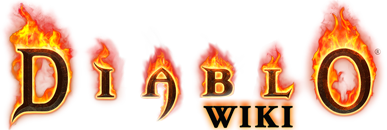
A Diablo III Health Potion.
Potions are Items depicted as small bottles of liquid. They are used throughout the Diablo series in varying capacities for recovery, enhancement, and protection.
Diablo I
Consumable Potions
Potions can be consumed to help the character by replenishing Life with Potions of Healing, Mana with Potions of Mana, or both with Potions of Rejuvenation.
Each type comes in two levels, a regular potion and a Full variant. The normal ones instantly recover a portion of their respective stat, while the full potions instantly recover 100%.
Elixirs
Elixirs are prevalent in Diablo I, adding 1 to 5 points to the appropriate attribute when they are consumed.
In Hellfire, Magic Elixirs completely refill your mana, and Vitality elixirs completely refill your life. Dexterity and Strength elixirs provide no bonus other than to the stat they boost.
As well as being dropped by monsters in the lower levels of the dungeons, elixirs are sold by both Pepin and Adria in single-player mode, although Adria sells them infrequently. Adria also sells them on a random basis in multiplayer to players who have entered Hell, the Hive or the Crypt (in Diablo: Hellfire). All elixirs cost 5000 gold, and elixirs of Vitality cannot be purchased.
They lost popularity because players thought the elixirs 'broke' the game. Their easy availability from Pepin the Healer at higher levels as well as the infamous item cloning trick led to many balance issues. It created a large number of characters with full stats fighting at low levels. Because of their infamy, elixirs were only available in Diablo II as quest rewards.
Diablo Demo Elixirs
The Elixirs used in Alpha were a bit more randomized, more often than not adding more than 1 point into the stat they affected. In addition, there were elixirs with effects that are negative, subtracting 1 to 5 points from one attribute.
Diablo II
Consumable Potions
Many types of potions can be consumed to help the characters in Diablo II by replenishing Life, Mana, and Stamina or curing Poison and Cold.
Throwing Potions
Other potions are used as deadly weapons that are thrown. There are two classes of throwing potions, Poison Potions which deal Poison damage and Fire Potions which deal Fire and Physical damage. To use them, simply equip them as you would any weapon. They are carried in stacks like Javelins and may be replenished by repairing them. Some monsters, such as the Slinger, will use them against you.
Later in the game their small damage is completely negligible. However, during the early and middle stages of the game, these potions are rather effective, allowing players to barrage oncoming monsters with area of effect damage. These potions are often more effective in dungeons and enclosed areas, as enemies will have less space to maneuver, and will often clump up.
Elixirs
Elixirs made a small comeback from Diablo II, but only as quest rewards. These mystical elixirs which may be brewed by talented alchemists like Alkor in Kurast. They permanently raise a character's attribute by a fixed number. The only example is the Potion of Life.
Diablo III
Potions have seen a reduced capacity in Diablo III.
Health Potions have been partially replaced by Health Globes. They come in ten levels of quality, with each level after the lowest one possessing a level requirement. Like in Diablo I, they heal a fixed amount instantly rather than over time.
Diablo I
Recovery — Healing Potions • Mana Potions
Elixirs — Elixir of Strength • Elixir of Vitality • Elixir of Magic • Elixir of Dexterity
Quest Potions — Golden Elixir • Spectral Elixir
Demo only elixirs — Elixir of Clumsiness • Elixir of Disillusion • Elixir of Weakness
Diablo II
Recovery — Healing Potions • Mana Potions • Rejuvenation Potions • Antidote Potion • Thawing Potion • Stamina Potion
Throwing — Poison Potions • Fire Potions
Quest Potions — Potion of Life • Malah's Potion
Diablo III
Recovery — Health Potions
